The Alluring Enigma of Flesh-Eating Flora: Mastering the Art of Growing and Nurturing Carnivorous Plants
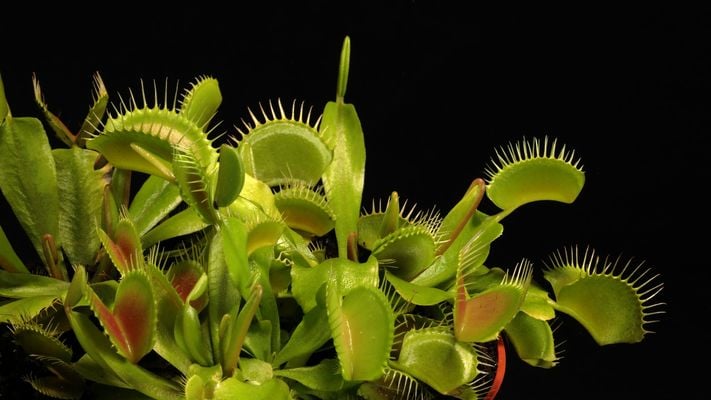
Introduction
Understanding Carnivorous Plants
Carnivorous plants are a fascinating group of flora that have evolved unique adaptations to capture, kill, and digest insects and other small organisms to supplement their nutrient intake. This ability to derive nutrients from their prey allows them to thrive in environments where other plants struggle, such as nutrient-poor soils or harsh climates. There are over 800 known species of carnivorous plants, each with their own unique trapping mechanisms and characteristics, ranging from the iconic Venus Flytrap to the intricate Pitcher Plants and the sticky Sundews.
Carnivorous plants can be classified based on their trapping mechanisms, which include snap traps, pitfall traps, flypaper traps, suction traps, and lobster-pot traps. These various trapping strategies have evolved to maximize the plants' ability to capture prey and derive essential nutrients, such as nitrogen and phosphorus, which are often scarce in their natural habitats.
Why Grow Carnivorous Plants?
Growing carnivorous plants can be a rewarding and engaging hobby, offering numerous benefits and opportunities for learning and enjoyment. Here are a few reasons why you might consider cultivating these captivating plants:
- Aesthetic Appeal: Carnivorous plants boast a wide range of stunning forms, colors, and textures, making them visually striking and unique additions to your garden or indoor space.
- Educational Value: Cultivating carnivorous plants can provide valuable insights into the world of plant biology, ecology, and evolution, offering a hands-on learning experience for people of all ages.
- Pest Control: By capturing and consuming insects, carnivorous plants can help reduce pest populations in your garden or home, potentially reducing your reliance on chemical pesticides.
- Conservation and Biodiversity: Many carnivorous plant species are threatened by habitat loss and other human-induced factors. By growing these plants in cultivation, you can contribute to their conservation and promote biodiversity in your garden or home.
- Novelty and Interest: The unique trapping mechanisms and behaviors of carnivorous plants make them a fascinating subject of study and conversation, providing endless opportunities for discovery and enjoyment.
By understanding the unique needs and characteristics of carnivorous plants, you can embark on a rewarding journey into the world of these remarkable flora and unlock their full potential as captivating additions to your garden or indoor space.
The World of Carnivorous Plants
The Science Behind Their Carnivorous Nature
The carnivorous nature of these fascinating plants is a result of their adaptation to nutrient-poor environments. In such habitats, the availability of essential nutrients like nitrogen, phosphorus, and potassium is limited, making it challenging for most plants to thrive. Carnivorous plants, however, have evolved unique mechanisms to capture and digest insects and other small organisms as an alternative source of nutrients.
The process of capturing and digesting prey involves a series of specialized adaptations and physiological processes, including:
- Attraction: Many carnivorous plants produce nectar or visual cues, such as bright colors, to attract unsuspecting insects and other prey to their traps.
- Capture: Once the prey is lured to the plant, it becomes trapped by the plant's specialized trapping mechanism. These mechanisms vary among species and include snap traps (e.g., Venus Flytrap), pitfall traps (e.g., Pitcher Plants), flypaper traps (e.g., Sundews), suction traps (e.g., Bladderworts), and lobster-pot traps (e.g., some species of Genlisea).
- Digestion: After capturing their prey, carnivorous plants secrete digestive enzymes to break down the insect's exoskeleton and internal tissues. These enzymes, similar to those found in animal digestive systems, allow the plant to extract essential nutrients like nitrogen and phosphorus from the prey's body.
- Absorption: The digested nutrients are then absorbed by the plant through specialized structures called "absorptive hairs" or "glandular trichomes," which facilitate nutrient uptake and transport to other parts of the plant.
- Reset: After the digestion and absorption processes are complete, the plant's trap resets, allowing it to capture more prey and continue supplementing its nutrient intake.
This remarkable ability to derive nutrients from prey allows carnivorous plants to survive and thrive in environments where other plants struggle, showcasing the incredible diversity and adaptability of the plant kingdom. Understanding the science behind their carnivorous nature can further deepen our appreciation for these unique and captivating flora.
Popular Carnivorous Plant Species
Venus Flytrap (Dionaea muscipula)
The Venus Flytrap is arguably the most famous carnivorous plant, with its iconic snap traps. It is native to subtropical wetlands in the United States and thrives in nutrient-poor, acidic soils.
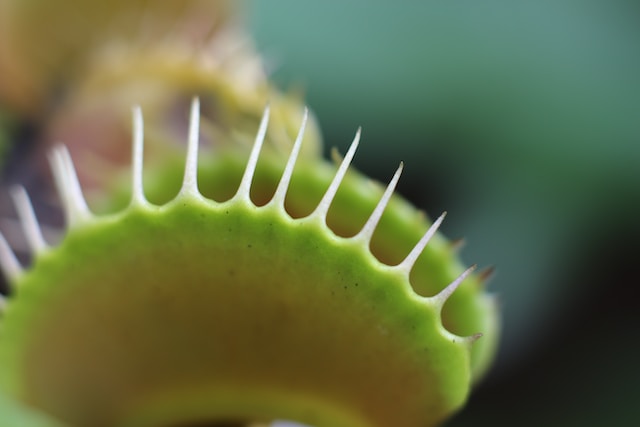
Pitcher Plants (Nepenthes, Sarracenia, and Heliamphora)
Pitcher plants are known for their tubular, modified leaves that form pitfall traps. They lure, capture, and digest prey by producing nectar and digestive enzymes within their pitchers. There are many species of pitcher plants with a wide range of shapes, sizes, and colors.
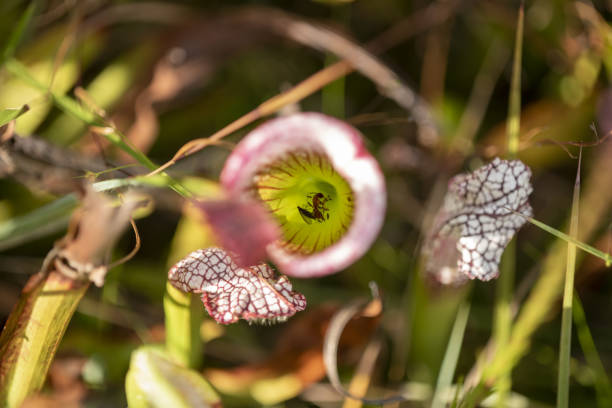
Sundews (Drosera)
Sundews are characterized by their sticky, glandular hairs that cover their leaves. These hairs secrete a sweet, sticky substance that attracts and ensnares insects. The plant then slowly digests the prey by releasing digestive enzymes.
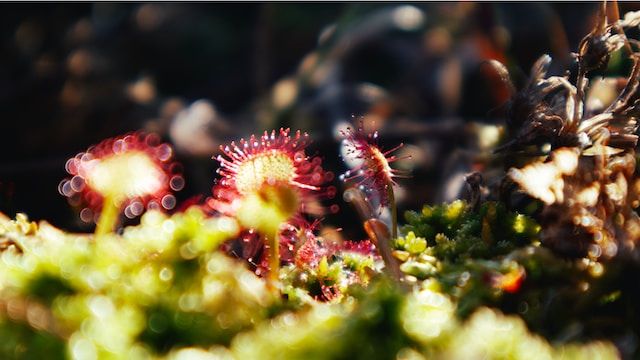
Butterworts (Pinguicula)
Butterworts are small, rosette-forming plants with flat, sticky leaves that function as flypaper traps. Their leaves secrete a mucilaginous substance to capture insects, and the plant produces digestive enzymes to absorb nutrients from its prey.
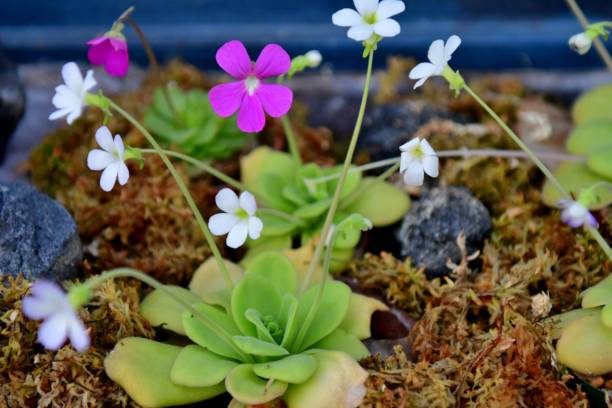
Bladderworts (Utricularia)
Bladderworts are aquatic or semi-aquatic plants that utilize suction traps to capture small aquatic organisms. These plants have tiny, bladder-like structures with a trapdoor mechanism that quickly opens and closes to capture prey.
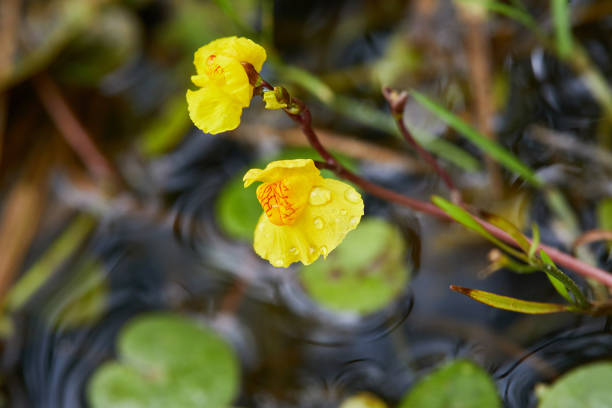
Selecting the Right Carnivorous Plant for Your Environment
Indoor vs. Outdoor Growing
When deciding to grow carnivorous plants, it's essential to consider whether you want to cultivate them indoors or outdoors, as this will influence your choice of species and the care required. Both indoor and outdoor growing environments have their benefits and challenges, which we will explore below:
Indoor Growing
Growing carnivorous plants indoors allows you to maintain a controlled environment, which can be especially beneficial for tropical species that require consistent warmth and humidity. Indoor cultivation also provides the opportunity to display these captivating plants in a prominent location where you can appreciate their beauty and observe their trapping mechanisms up close. Some popular indoor carnivorous plant species include Nepenthes (Tropical Pitcher Plants), Pinguicula (Butterworts), and some Drosera (Sundews).
Challenges of indoor growing include maintaining adequate light levels, temperature, and humidity to meet the specific needs of your chosen species. This may require supplemental lighting, a terrarium or greenhouse setup, or other specialized equipment to create the ideal conditions for your plants to thrive.
Outdoor Growing
Growing carnivorous plants outdoors allows them to experience natural light and temperature fluctuations, which can be beneficial for temperate species that require a period of winter dormancy. Outdoor cultivation also enables you to create a dedicated bog garden or incorporate carnivorous plants into your existing landscape design. Some popular outdoor carnivorous plant species include Sarracenia (North American Pitcher Plants), Dionaea muscipula (Venus Flytrap), and Drosera (Sundews).
Challenges of outdoor growing include protecting your plants from extreme weather conditions, pests, and diseases. Additionally, you will need to ensure the plants receive the appropriate amount of sunlight, water, and nutrients to meet their specific requirements.
Ultimately, your choice between indoor and outdoor growing will depend on the species you wish to cultivate, the climate in your region, and your personal preferences. By understanding the specific needs of your chosen carnivorous plant species and providing the appropriate care, you can successfully grow these captivating flora in either an indoor or outdoor environment.
Regional Considerations and Climate
When choosing carnivorous plants to grow, it is essential to consider your region's climate and its compatibility with the specific needs of your chosen species. Carnivorous plants are native to various habitats worldwide, from the tropical rainforests of Southeast Asia to the temperate bogs of North America. Understanding the climate requirements of each species will help ensure their successful cultivation and long-term health.
Tropical Species
Tropical carnivorous plants, such as Nepenthes (Tropical Pitcher Plants) and many species of Drosera (Sundews) and Utricularia (Bladderworts), typically require consistently warm temperatures and high humidity levels. These species are well-suited for indoor cultivation in terrariums or greenhouses, where you can maintain a controlled environment. If you live in a tropical or subtropical climate, it may be possible to grow these species outdoors year-round, provided you can maintain the necessary conditions.
Temperate Species
Temperate carnivorous plants, such as Sarracenia (North American Pitcher Plants), Dionaea muscipula (Venus Flytrap), and many species of Drosera (Sundews) and Pinguicula (Butterworts), are adapted to cooler climates with distinct seasonal fluctuations. Many temperate species require a period of winter dormancy, during which they experience reduced growth and metabolic activity in response to cold temperatures and decreased sunlight. These plants can be grown outdoors in most temperate regions, provided they are protected from extreme weather conditions and given appropriate care.
High-Altitude Species
Some carnivorous plants, such as Heliamphora (Sun Pitcher Plants) and certain species of Pinguicula (Butterworts) and Utricularia (Bladderworts), are native to high-altitude environments, where they experience cool temperatures, high humidity, and intense sunlight. These species can be challenging to grow in cultivation and may require specialized care, such as supplemental lighting or a dedicated high-humidity chamber.
When selecting a carnivorous plant species to grow, consider the climate in your region and the specific needs of the plant. By providing the appropriate care and growing conditions, you can ensure the long-term health and success of your captivating carnivorous flora.
Growing Conditions and Requirements
Successfully cultivating carnivorous plants requires an understanding of their specific growing conditions and requirements. By providing the appropriate care, you can ensure the health and well-being of these fascinating flora. Below are some essential factors to consider when growing carnivorous plants:
Soil and Potting Mixes
Carnivorous plants generally require a nutrient-poor, well-draining potting mix that mimics their natural habitats. A popular potting mix for most carnivorous plant species consists of a blend of sphagnum peat moss and perlite or sand. It is essential to avoid using standard potting soil or fertilized mixes, as these can contain harmful nutrients that may damage or kill your plants.
Watering Needs and Techniques
Carnivorous plants typically require a consistent supply of water to maintain their health and vitality. Many species are adapted to growing in boggy environments and need consistently moist soil to thrive. It is crucial to use pure water sources, such as rainwater, distilled water, or reverse osmosis water, as tap water may contain minerals or chemicals that can harm your plants.
To maintain consistent soil moisture, many growers use a tray or saucer filled with water beneath the pot, allowing the plants to wick up water as needed. This method, called the "tray method," helps maintain a consistently moist environment for your plants without the risk of overwatering. Be sure to monitor the water level in the tray and replenish as needed.
Light and Temperature Requirements
Carnivorous plants generally require bright light to support their growth and encourage the development of their unique trapping structures. Most species will thrive in direct sunlight or under bright artificial lights, such as fluorescent or LED grow lights. Be sure to provide the appropriate light levels for your chosen species, as some plants may have specific requirements.
Temperature requirements vary among carnivorous plant species, with tropical plants typically requiring consistently warm conditions and temperate species needing cooler temperatures and a period of winter dormancy. It is essential to understand the temperature needs of your chosen species and provide a suitable environment to ensure their health and vitality.
Feeding and Nutrient Needs
Carnivorous plants have evolved to capture and digest insects and other small organisms as a means of supplementing their nutrient intake in nutrient-poor environments. However, when growing carnivorous plants in cultivation, it is essential to understand their feeding and nutrient needs to ensure their long-term health and success.
Natural Prey Sources
Carnivorous plants can generally obtain sufficient nutrients from their natural prey, such as insects and other small organisms. If your plants are grown outdoors or have access to a natural source of prey, additional feeding may not be necessary. However, it is essential to monitor your plants' health and growth, as signs of nutrient deficiency may indicate the need for supplemental feeding.
Artificial Feeding Options
If your carnivorous plants are grown indoors or do not have access to a natural source of prey, you may need to provide supplemental feeding to ensure they receive the necessary nutrients. Some options for artificial feeding include:
- Insects: Live or dead insects, such as crickets, mealworms, or fruit flies, can be used to feed your plants. Be sure to use appropriately sized insects for your plant species, as larger insects may be difficult for the plant to digest and may cause damage.
- Prepared Carnivorous Plant Food: Some commercial products are specifically designed to meet the nutritional needs of carnivorous plants. These products can be applied as a spray or directly to the plant's traps, depending on the manufacturer's instructions.
- Homemade Nutrient Solutions: Dilute solutions of water and a high-nitrogen fertilizer, such as orchid fertilizer, can be used to supplement your plants' nutrient intake. However, it is crucial to use a very weak solution and apply it sparingly, as excessive nutrients can damage or kill your plants.
When providing supplemental feeding for your carnivorous plants, it is essential to avoid overfeeding, as this can lead to nutrient imbalances and other health issues. Monitor your plants' health and growth closely, adjusting your feeding regimen as needed to ensure their long-term success.
Propagation and Reproduction
Propagating and reproducing carnivorous plants can be an exciting and rewarding process. Understanding the various propagation methods available for your chosen species can help ensure the success of your propagation efforts.
Seeds
Growing carnivorous plants from seed is a popular and rewarding method of propagation. However, it can be a slow process, and some species may be challenging to grow from seed. To increase your chances of success, it is essential to use fresh seed, provide appropriate growing conditions, and be patient, as some species may take several years to reach maturity.
When sowing carnivorous plant seeds, it is crucial to use an appropriate potting mix, such as a sphagnum peat moss and perlite blend. Be sure to provide adequate light and maintain a consistently moist environment to support seed germination and early growth. Transplant seedlings to individual pots as they outgrow their seedling trays, being careful not to damage their delicate roots.
Vegetative Propagation
Vegetative propagation is a fast and efficient method of propagating carnivorous plants that involves creating new plants from existing plant material. Some common vegetative propagation methods include:
- Division: Many carnivorous plant species, such as Sarracenia and Nepenthes, form clumps or rosettes of leaves that can be divided into individual plants. To divide a plant, carefully remove it from its pot and gently tease apart the individual rosettes or clumps. Repot each division into its pot with fresh potting mix.
- Leaf Pulling: Some carnivorous plant species, such as Drosera and Pinguicula, can be propagated by pulling individual leaves from the parent plant and placing them in a potting mix. With proper care and growing conditions, the leaves will develop into new plants.
- Cuttings: Certain carnivorous plant species, such as Nepenthes, can be propagated by taking stem cuttings and rooting them in a suitable potting mix.
Tissue Culture
Tissue culture is a specialized propagation method that involves growing plants from small pieces of plant tissue, such as leaves or stems, in a sterile laboratory environment. Tissue culture is a valuable tool for conserving rare or endangered carnivorous plant species and producing large numbers of genetically identical plants. However, tissue culture requires specialized equipment and expertise and may not be practical for most home growers.
By understanding the various propagation methods available for your chosen carnivorous plant species, you can successfully propagate and reproduce these captivating plants and expand your collection.
Common Pests and Diseases
Like all plants, carnivorous plants are susceptible to pests and diseases that can damage or kill them. Understanding the most common pests and diseases that affect carnivorous plants can help you identify and treat problems before they become severe.
Identifying Pests and Diseases
Some of the most common pests and diseases that affect carnivorous plants include:
- Aphids: These small, soft-bodied insects can damage plant tissue and spread viruses.
- Spider Mites: These tiny pests can cause yellowing and wilting of plant leaves.
- Fungal Diseases: Carnivorous plants are susceptible to fungal diseases, such as powdery mildew and leaf spot, which can cause leaf damage and defoliation.
- Root Rot: Overwatering or poorly-draining soil can cause root rot, a condition in which the roots of the plant begin to rot and decay.
- Mealybugs: These small, white insects can suck sap from the plant, causing wilting and stunted growth.
Preventive Measures and Treatments
Preventing and treating pests and diseases in carnivorous plants can be challenging, as many conventional pesticides and fungicides can harm or kill these sensitive plants. However, some preventative measures and treatments include:
- Quarantine: Always quarantine new plants to prevent the introduction of pests and diseases into your collection.
- Good Growing Conditions: Providing appropriate growing conditions, such as good air circulation, appropriate light levels, and well-draining soil, can help prevent pest and disease problems.
- Natural Predators: Introducing natural predators, such as ladybugs or predatory mites, can help control pest populations without harming your plants.
- Organic Treatments: Some organic treatments, such as neem oil or insecticidal soap, can help control pest populations without harming your plants. However, it is essential to test any treatments on a small area of the plant first to ensure they do not cause harm.
- Removal: In severe cases, it may be necessary to remove affected plant tissue or entire plants to prevent the spread of disease.
Tips for Long-Term Care and Maintenance
Carnivorous plants can be fascinating and rewarding plants to grow, but they do require specialized care and maintenance to thrive over the long term. The following tips can help you ensure the health and longevity of your carnivorous plants.
Winter Dormancy and Seasonal Care
Many carnivorous plant species require a period of winter dormancy, during which they enter a state of reduced growth and metabolism. It is essential to provide appropriate care during this time, such as reducing watering and providing cooler temperatures, to ensure the plant enters and exits dormancy successfully. It is also important to adjust your feeding regimen during dormancy, as most carnivorous plants do not require additional feeding during this time.
Pruning and Grooming
Regular pruning and grooming can help keep your carnivorous plants healthy and attractive. Remove any dead or damaged leaves or traps promptly, as they can harbor pests or diseases that can spread to healthy tissue. Groom your plants regularly by removing dead insects or other debris from the traps to prevent them from decomposing and attracting harmful bacteria.
Repotting
Carnivorous plants generally prefer to be slightly root-bound, but they may need to be repotted occasionally to maintain their health and growth. Repotting should be done during the growing season and using a fresh potting mix that is appropriate for your plant species.
Water Quality
Carnivorous plants are sensitive to the quality of the water they receive. They require pure, mineral-free water, such as rainwater, distilled water, or reverse osmosis water. If using tap water, it is essential to remove any chlorine or other chemicals before use.
Pest and Disease Prevention
Preventing pests and diseases is essential to maintaining the health and longevity of your carnivorous plants. Proper growing conditions, good hygiene practices, and natural pest control methods can help prevent many common problems.
Incorporating Carnivorous Plants into Your Garden
Carnivorous plants can be a unique and eye-catching addition to any garden. The following tips can help you incorporate these captivating plants into your outdoor space.
Design Ideas and Inspirations
Carnivorous plants can be incorporated into a range of garden styles, from formal to whimsical. Some design ideas and inspirations include:
- Grouping: Grouping several carnivorous plant species together in a designated area can create a dramatic and eye-catching display.
- Containers: Planting carnivorous plants in containers, such as ceramic pots or hanging baskets, can add visual interest to patios or outdoor living areas.
- Water Features: Many carnivorous plant species, such as pitcher plants, thrive in moist environments, making them ideal for water features or bog gardens.
- Rock Gardens: Carnivorous plants, such as Venus Flytraps or Sundews, can add texture and interest to rock gardens or dry landscapes.
Companion Plants and Biodiversity
Incorporating carnivorous plants into your garden can also help promote biodiversity and attract beneficial insects and wildlife. Some companion plants that pair well with carnivorous plants include:
- Wildflowers: Wildflowers, such as bee balm or coneflowers, can attract pollinators that can benefit both your carnivorous plants and other garden plants.
- Native Grasses: Native grasses, such as switchgrass or bluestem, can help support a range of wildlife and add visual interest to your garden.
- Water Plants: Incorporating water plants, such as water lilies or water hyacinths, can create a lush and vibrant aquatic environment for your carnivorous plants.
Summary...
Growing and nurturing carnivorous plants can be a unique and rewarding experience for plant enthusiasts. These captivating plants have evolved specialized adaptations to capture and digest their prey, making them a fascinating addition to any plant collection or garden.
Understanding the diverse range of carnivorous plant species, their unique growing requirements, and their susceptibility to pests and diseases can help ensure the health and longevity of these intriguing plants.
By providing appropriate growing conditions, such as well-draining soil, pure water, and appropriate lighting and temperature, and incorporating natural pest control methods and good hygiene practices, you can help prevent and treat common pest and disease problems.
Carnivorous plants can be incorporated into a range of garden styles and paired with complementary companion plants to create a visually stunning and ecologically diverse outdoor space.
Whether you are a seasoned plant enthusiast or new to the world of carnivorous plants, the information presented in this article can help you master the art of growing and nurturing these alluring and enigmatic flesh-eating flora.
Frequently Asked Questions (FAQs)
Are Carnivorous Plants Safe for Pets and Children?
While carnivorous plants are generally safe for pets and children, it is essential to keep in mind that they are not edible and can cause stomach upset if ingested. It is also important to avoid allowing pets or children to handle or play with the traps, as this can damage the plant and create a potential choking hazard.
Can I Grow Carnivorous Plants from Seeds or Clippings?
Yes, carnivorous plants can be grown from seeds or clippings. However, some species may be more challenging to propagate than others, and specific growing conditions may be required for successful growth. To grow from seeds, it is essential to provide a suitable growing environment, including appropriate soil, water, lighting, and temperature conditions. To grow from clippings, take a cutting from a healthy plant and plant it in a suitable growing medium, such as sphagnum moss or a carnivorous plant potting mix.
How Do I Know If My Plant Is Getting Enough Nutrients?
Carnivorous plants obtain most of their nutrients from capturing and digesting prey, but they also require some additional nutrients, such as nitrogen and phosphorus, that may be lacking in their growing environment. Signs that your plant may not be getting enough nutrients include stunted growth, pale or yellowing leaves, and reduced trapping or digestive function. To ensure your plant is getting enough nutrients, provide it with a consistent feeding schedule using appropriate prey or feeding products.
Do Carnivorous Plants Require Special Fertilizers?
Carnivorous plants do not require traditional fertilizers, as they obtain most of their nutrients from capturing and digesting prey. However, they may benefit from occasional feeding with low-nitrogen fertilizers or specialized carnivorous plant fertilizers. These fertilizers provide the additional nutrients that may be lacking in the plant's growing environment and help support healthy growth and development.
What Is the Lifespan of a Carnivorous Plant?
The lifespan of a carnivorous plant varies depending on the species and growing conditions. Some species, such as Venus Flytraps, may live for several years under optimal conditions, while others may have a shorter lifespan. Proper care, including appropriate growing conditions, regular feeding, and maintenance, can help extend the lifespan of your carnivorous plant.
Can Carnivorous Plants Survive in Low-Light Conditions?
Most carnivorous plant species require bright, indirect light to thrive. However, some species, such as Sundews, Butterworts, and some Nepenthes, can tolerate lower light conditions. If growing carnivorous plants in low-light environments, it is essential to provide supplemental lighting or choose a species that is well-suited to low-light conditions.
How Often Should I Water My Carnivorous Plant?
Carnivorous plants have specific watering requirements, and over or under watering can be detrimental to their health. As a general rule, keep the soil or growing medium consistently moist but not waterlogged. Allow the top layer of soil to dry out slightly between watering to avoid water buildup and root rot. The frequency of watering will vary depending on the species, growing conditions, and time of year.
Blog Categories
Recent posts
- When You’re in Charlotte and They’re in Boone: An Honest Guide to Watauga Medical Center Flower Delivery
- The Alvin TX Bouquet: Why Lilac Surprise Dominates 1 in 3 Orders
- 3 Must Have Plants For Loved Ones In Danville
- What Are Our Most Searched Flowers State by State
- What Is It About New Yorkers Love Of Flowers?
- 4 Flowers You’ll Want to Grow in Your Small Garden
